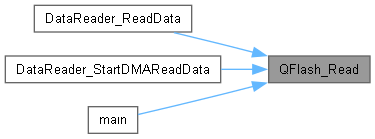 |
Da Vinci Firmware 1
Firmware for the DaVinci-M rocket avionics board.
|
 |
Da Vinci Firmware 1
Firmware for the DaVinci-M rocket avionics board.
|
Core functions for reading, writing, and erasing the flash memory. More...

Functions | |
| HAL_StatusTypeDef | QFlash_Read (uint32_t address, uint8_t *buffer, uint32_t dataSize) |
| HAL_StatusTypeDef | QFlash_Write (uint32_t addr, uint8_t *data, uint32_t dataSize) |
| HAL_StatusTypeDef | QFlash_SErase4k (uint32_t addr) |
| HAL_StatusTypeDef | QFlash_BErase32k (uint32_t addr) |
| HAL_StatusTypeDef | QFlash_BErase64k (uint32_t addr) |
| HAL_StatusTypeDef | QFlash_ChipErase (void) |
Core functions for reading, writing, and erasing the flash memory.
| HAL_StatusTypeDef QFlash_BErase32k | ( | uint32_t | addr | ) |
Definition at line 968 of file z_qflash_W25QXXX.c.
References FLASH_QSPI_PORT, HAL_ERROR, HAL_OK, QFLASH_DEF_TIMEOUT, QFlash_DefaultCmd(), QFlash_WaitForWritingComplete(), QFlash_WriteEnable(), QSpiAvailable, and W25_B_ERASE32K.

| HAL_StatusTypeDef QFlash_BErase64k | ( | uint32_t | addr | ) |
Definition at line 1008 of file z_qflash_W25QXXX.c.
References FLASH_QSPI_PORT, HAL_ERROR, HAL_OK, QFLASH_DEF_TIMEOUT, QFlash_DefaultCmd(), QFlash_WaitForWritingComplete(), QFlash_WriteEnable(), QSpiAvailable, and W25_B_ERASE64K_4B.

| HAL_StatusTypeDef QFlash_ChipErase | ( | void | ) |
Definition at line 1045 of file z_qflash_W25QXXX.c.
References FLASH_QSPI_PORT, HAL_ERROR, HAL_OK, QFLASH_DEF_TIMEOUT, QFlash_DefaultCmd(), QFlash_WaitForWritingComplete(), QFlash_WriteEnable(), QSpiAvailable, and W25_CH_ERASE.
Referenced by main().


| HAL_StatusTypeDef QFlash_Read | ( | uint32_t | address, |
| uint8_t * | buffer, | ||
| uint32_t | dataSize | ||
| ) |
Definition at line 379 of file z_qflash_W25QXXX.c.
References FLASH_QSPI_PORT, HAL_ERROR, HAL_OK, QFLASH_ALT_BYTES, QFLASH_ALT_BYTES_M, QFLASH_ALT_BYTES_S, QFLASH_DEF_TIMEOUT, QFlash_DefaultCmd(), QFLASH_READ_COMMAND, QFLASH_READ_DUMMYC, QFlash_WaitForDataAvailable(), QSpiAvailable, and QSpiReadDataAvailable.
Referenced by DataReader_ReadData(), DataReader_StartDMAReadData(), and main().


| HAL_StatusTypeDef QFlash_SErase4k | ( | uint32_t | addr | ) |
Definition at line 930 of file z_qflash_W25QXXX.c.
References FLASH_QSPI_PORT, HAL_ERROR, HAL_OK, QFLASH_DEF_TIMEOUT, QFlash_DefaultCmd(), QFlash_WaitForWritingComplete(), QFlash_WriteEnable(), QSpiAvailable, and W25_S_ERASE4K_4B.

| HAL_StatusTypeDef QFlash_Write | ( | uint32_t | addr, |
| uint8_t * | data, | ||
| uint32_t | dataSize | ||
| ) |
Definition at line 875 of file z_qflash_W25QXXX.c.
References EXT_FLASH_PAGE_SIZE, HAL_ERROR, HAL_OK, QFlash_WaitForWritingComplete(), QFlash_WriteASinglePage(), and QFlash_WriteEnable().
Referenced by check_Calibrating_phase(), and StartKalman_mkf().

